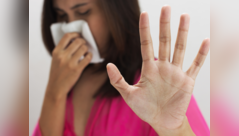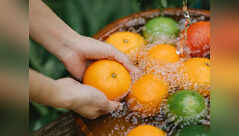01/5Tips to wash fruits and vegetables in the right way

Health experts always suggest to include at least 5 servings of fruits and vegetables daily. Eating colorful vegetables and fruits have multiple benefits for health. But they can also pose the risk of infection if not cleaned or washed thoroughly.
Fruits and vegetables can become contaminated during growth, harvest, storage, transportation, or preparation. They may be exposed to contaminated soil, water, or animals, or they may come into contact with contaminated surfaces during processing, packaging, or handling. Also in India, we usually buy fruits and vegetables from markets that mainly supply to the masses.
02/5Increased chances of contamination


The vendors who usually sell them have a low standard of personal and domestic hygiene and also the public place where they sell is not well sanitised. This poor sanitation and handling lead to the contamination of fruits and vegetables by microorganisms which causes gastrointestinal disorders. Therefore, it becomes important for us to wash fruits and vegetables before cutting and eating them. There’s more to washing them than just cleaning the dirt off them. Let’s learn the right way to wash them to safeguard ourselves.
03/5Points to remember:


>Wash your hands thoroughly before handling them.
>Wash them before peeling even if you do not want to consume the skin.
>Cruciferous and leafy greens: Separate and soak leaves or florets in a large bowl of cold water for one to two minutes, drain the leaves in a colander and dry with a clean towel. Rub with your hands while holding under a heavy stream of cold water and dry in a colander if needed.
04/5Tips for delicate fruits and veggies


>Delicate fruits and vegetables (berries): Turn gently in your hands while holding under a soft stream of cold water and spread on a clean towel to dry.
>Roots and tuber: Using a vegetable brush, scrub while holding under a heavy stream of cold water and dry using a clean towel.
>Mushrooms: Swirl in a colander while spraying with a heavy stream of cold water and transfer to a clean towel to dry.
05/5In a nutshell


Note that it is not recommended to use soap or detergent to wash fruits and vegetables as it may leave harmful residues. Additionally, it is unnecessary to use commercial produce washes or vegetable washes or vinegar as they are no more effective than rinsing with water.
It is also important how we handle fruits and vegetables after washing them. For example, cutting boards, knives, and other utensils used for cutting or peeling produce should be clean and sanitized to prevent cross-contamination with other foods. Additionally, fruits and vegetables should be stored properly to prevent further contamination or spoilage. By taking these precautions, you can reduce the risk of foodborne illness and enjoy the health benefits of a diet rich in fruits and vegetables.
By: Nahid Khilji, Co-Founder, Health Hatch






















































closecomments
SIGN IN WITH
FacebookGoogleEmail